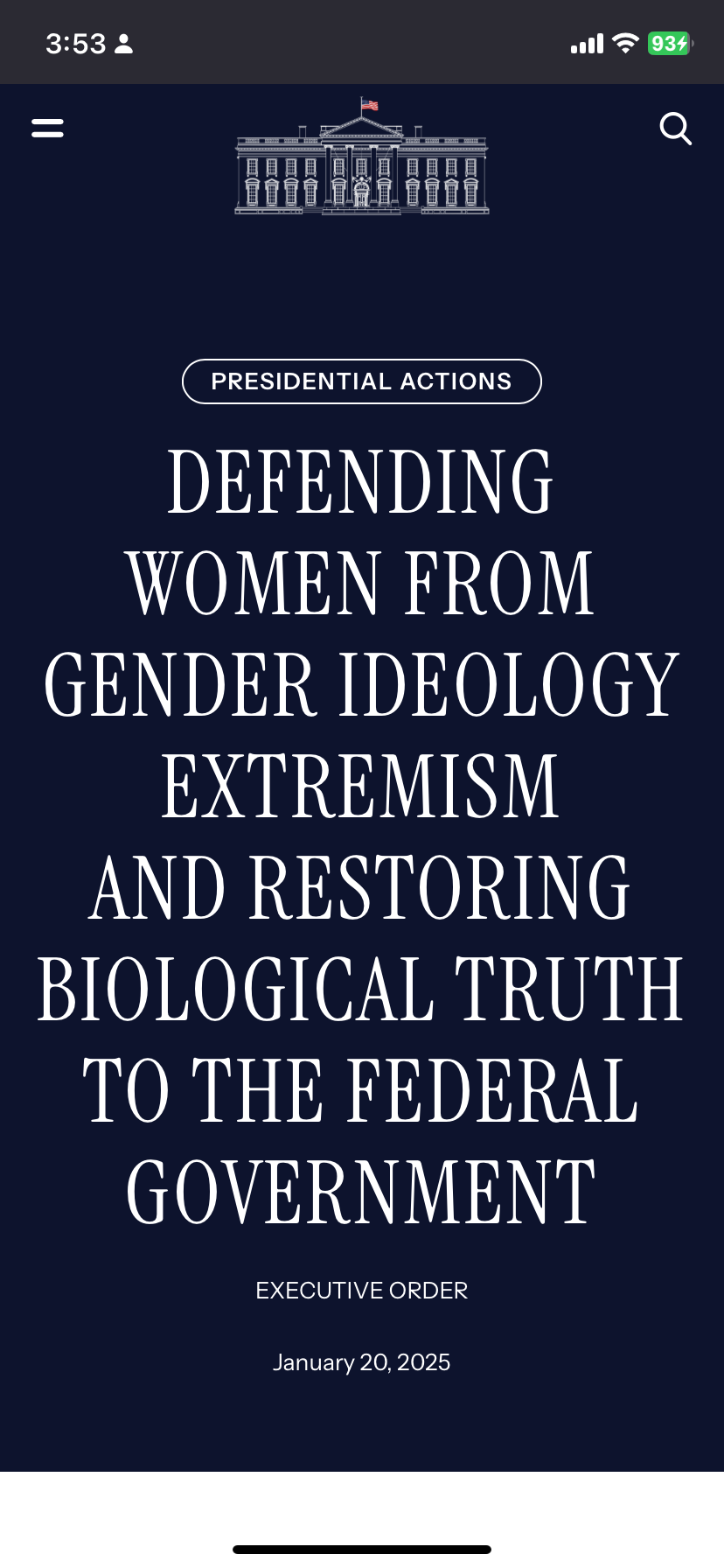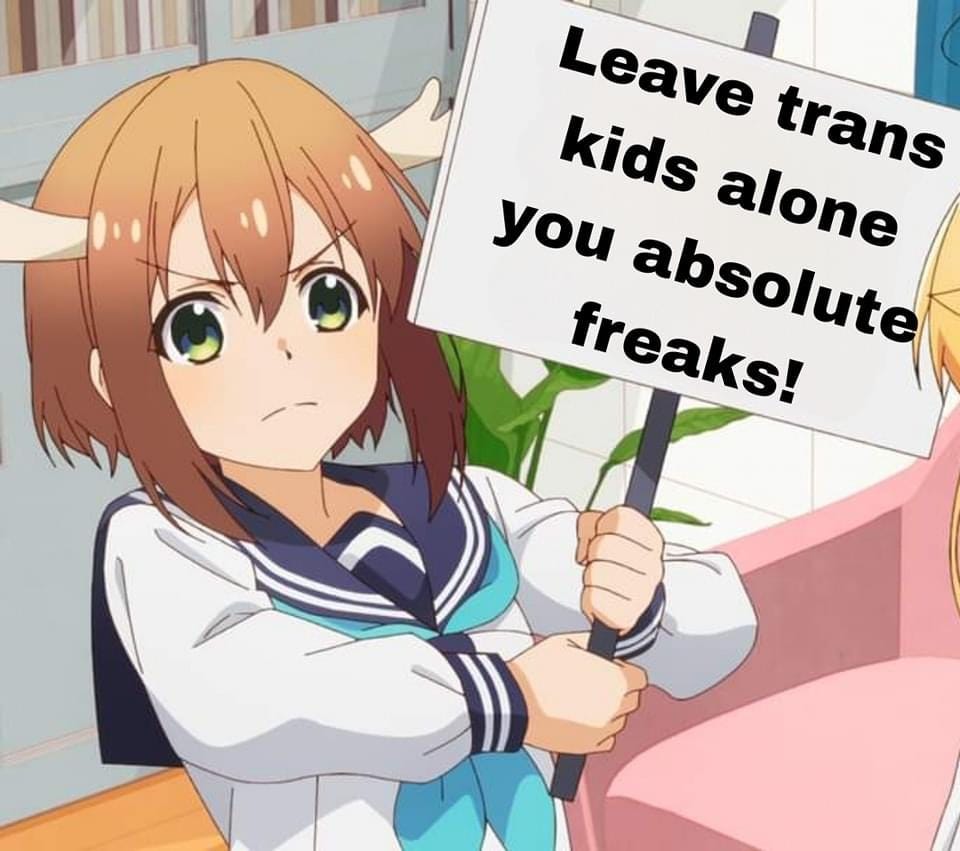Trump’s Transphobic Executive Order: Worse Than Expected
Every Trans Person is Going to Feel Awful About Everything Now
There’s no other way of saying it. This thing will go down in history as the Nuremberg Race Laws of the Trump war on the non-cis world.
President Donald Trump issued an Executive Order, DEFENDING WOMEN FROM GENDER IDEOLOGY EXTREMISM AND RESTORING BIOLOGICAL TRUTH TO THE FEDERAL GOVERNMENT, immediately following his January 20, 2025 Inauguration that seeks to systemically dismantle every potential avenue of civil liberties and protections for the non-cis population of the country. The document is a thoroughgoing attempt to exclude trans existence and people from public accommodations. As a trans teacher, the final subsection naming federal guidance documents that are hereby rescinded made me shed tears involuntarily:
…Each agency head shall promptly rescind all guidance documents inconsistent with the requirements of this order or the Attorney General’s guidance issued pursuant to this order, or rescind such parts of such documents that are inconsistent in such manner. Such documents include, but are not limited to:
(i) “The White House Toolkit on Transgender Equality”;
(ii) the Department of Education’s guidance documents including:
(A) “2024 Title IX Regulations: Pointers for Implementation” (July 2024);
(B) “U.S. Department of Education Toolkit: Creating Inclusive and Nondiscriminatory School Environments for LGBTQI+ Students”;
(C) “U.S. Department of Education Supporting LGBTQI+ Youth and Families in School” (June 21, 2023);
(D) “Departamento de Educación de EE.UU. Apoyar a los jóvenes y familias LGBTQI+ en la escuela” (June 21, 2023);
(E) “Supporting Intersex Students: A Resource for Students, Families, and Educators” (October 2021);
(F) “Supporting Transgender Youth in School” (June 2021);
(G) “Letter to Educators on Title IX’s 49th Anniversary” (June 23, 2021);
(H) “Confronting Anti-LGBTQI+ Harassment in Schools: A Resource for Students and Families” (June 2021);
(I) “Enforcement of Title IX of the Education Amendments of 1972 With Respect to Discrimination Based on Sexual Orientation and Gender Identity in Light of Bostock v. Clayton County” (June 22, 2021);
(J) “Education in a Pandemic: The Disparate Impacts of COVID-19 on America’s Students” (June 9, 2021); and
(K) “Back-to-School Message for Transgender Students from the U.S. Depts of Justice, Education, and HHS” (Aug. 17, 2021);
(iii) the Attorney General’s Memorandum of March 26, 2021 entitled “Application of Bostock v. Clayton County to Title IX of the Education Amendments of 1972″; and
(iv) the Equal Employment Opportunity Commission’s “Enforcement Guidance on Harassment in the Workplace” (April 29, 2024).
It is simply impossible to ignore the altogether malicious manner by which this document targets non-cis students.
But this passage is the more alarming:
(e) Agencies shall remove all statements, policies, regulations, forms, communications, or other internal and external messages that promote or otherwise inculcate gender ideology, and shall cease issuing such statements, policies, regulations, forms, communications or other messages. Agency forms that require an individual’s sex shall list male or female, and shall not request gender identity. Agencies shall take all necessary steps, as permitted by law, to end the Federal funding of gender ideology.
(f) The prior Administration argued that the Supreme Court’s decision in Bostock v. Clayton County (2020), which addressed Title VII of the Civil Rights Act of 1964, requires gender identity-based access to single-sex spaces under, for example, Title IX of the Educational Amendments Act. This position is legally untenable and has harmed women. The Attorney General shall therefore immediately issue guidance to agencies to correct the misapplication of the Supreme Court’s decision in Bostock v. Clayton County (2020) to sex-based distinctions in agency activities. In addition, the Attorney General shall issue guidance and assist agencies in protecting sex-based distinctions, which are explicitly permitted under Constitutional and statutory precedent.
(g) Federal funds shall not be used to promote gender ideology. Each agency shall assess grant conditions and grantee preferences and ensure grant funds do not promote gender ideology
Obviously the most immediate issue that stands out to readers is the notion of Title IX funding for gender-exclusionary sports programs and leagues.
But the more foreboding notion is the manipulation of the Educational Amendment Acts as a method for denying school districts funding for noncompliance in regards to anything from LGBTQ-affirmative curriculum standards set by the Rhode Island Department of Education to a school board hiring non-cis teachers.
This thing hurt to read. In the memoirs of the Black abolitionist Harriet Jacobs, she describes a horror film scenario in the distinctive experience of misogynoir enwrapping the entirety of her existence. The most potent symbol of this is the days on end she spends helplessly trapped in a tiny attic crawl space above the living quarters of the Africans held in captivity in the antebellum United States. Hypothetically, because of how long she had been hidden in the crawl space, it was presumed she had in fact succeeded in self-emancipation. But in spite of this, owing to a number of reasons of deep and personal resonance, she is unable to leave the plantation without her children. And so freedom instead is a kind of sadistic taunt. She lays down in the attic for seven years hiding from her captors but with the window frame of the garret serving the same equivalent of such a porthole in a contemporaneous prison complex. She is unable to escape the policing of her body even when she is supposedly free because of the scrutiny imposed upon her owing to her nationality and gender/sex identity.
If we understand properly that the United States, owing to its nature as a settler colonial society, is built on the policing of the non-European non-cis non-heterosexual population, we should not be surprised to see such developments, precisely because of the accounts of such Black proletarian literature describing such carceral tendencies of the state. But it still hurt.
‘Die Moorsoldaten’ <The Moor Soldiers> was written by the very few who were able to escape from the concentration camps and attempted to warn the West about Hitler’s plan. Paul Robeson’s rendition is particularly powerful and feels most apt given the circumstances. This graf from the ORT educational website focused on music and the Nazi holocaust reports:
The focus of the song’s lyrics is the ‘peat bog soldiers,’ as the prisoners proudly called themselves. The name comes from the fact that the spades they carried on their shoulders looked like rifles. This designation is a demonstration of the prisoners’ strength and it is this that lends the song its programmatic character. The lyrics are descriptive and easy to follow and express the situation of the prisoners in their own simple language. They do contain some coded expressions (‘moor soldiers,’ ‘hidden away,’ ‘it cannot be winter forever’), but it is not truly revolutionary. Nevertheless, the song’s text articulates an accusation against the Nazi regime. This aspect can only be fully appreciated through understanding of the song’s context. Even the last stanza can be understood in multiple ways. It could mean either the prisoners’ release from the camp or Germany’s release from Hitler. For the former Börgermoor prisoner Karl Schabrod, ‘It was a song of consolation, a consolation and fight song and a song of camaraderie.’ Junge emphasized the significance of the song for the prisoner community: ‘This song was our camp song, even if its politics are not as explicit as later songs. It still was the first song and it became the real concentration camp song.’
Goguel intentionally designed the refrain to be defiant as a means of creating musical contrast. It begins with a jump of a sixth that has an emotional and dramatic effect. A variation in the lyrics and music in the last refrain serves to express the certitude that freedom will eventually come (something entirely realistic at this point) and that the fight against the Nazis will continue. Instead of ‘We are the peat bog soldiers / and travel spade in hand / into the moor,’ in the final refrain it is: ‘Then the peat bog soldiers / no longer travel spade in hand / into the moor.’ The song ends in an optimistic major resolution, resisting falling back into the minor key of the fundamental motif otherwise held steadily throughout. This simple but effective variation dramatically symbolizes the protest, the will to survive, and the resistance of the political prisoners. Through this modulation between the minor and parallel major scale, the song appears simultaneously melancholic and hopeful. Indeed, by the finale it is demanding, even defiant. This quality was amplified when sung by the prisoners through their emphasis on the word ‘no.’ They did this, for example, by stamping their feet. Heinz Junge notes: ‘Their stomping reverberated on the wooden floorboards of the barracks. This stomping on the boards was also common in other camps.’…
Wolfgang Langhoff estimates that ‘hundreds of copies’ - handwritten copies or song sheets - of the ‘Börgermoorlied’ (Song of Börgermoor), better known as the ‘Moorsoldatenlied’ (‘Song of the Peat Bog Soldiers’) were secretly smuggled to the outside world shortly after its premiere by inmates and even some SS guards. Released prisoners also relayed the story of the song to others in the Ruhr area. Prisoner transfers spread the song still further to other camps and detention centers.
In most of the new generation concentration camps, those built after 1936, the ‘Song of the Peat Bog Soldiers’ became known as a type of anthem for the political prisoners. Some of the ‘moor soldiers’ brought ‘their’ song to other camps, most notably Sachsenhausen, where it was sung not only by the prisoners but also by the SS. It eventually found its way into numerous handwritten concentration camp song books. Even as late as 1944, Thomas Geve could learn of the ‘Song of the Peat Bog Soldiers’ in Auschwitz. Despite the drastic changes to the concentration camp system in the intervening period, Geve and his comrades took up this old camp song because its message had remained salient. In doing so, they sought to create a conscious bridge to the older concentration camps.
The notion of making your voice heard however possible is truly powerful.






